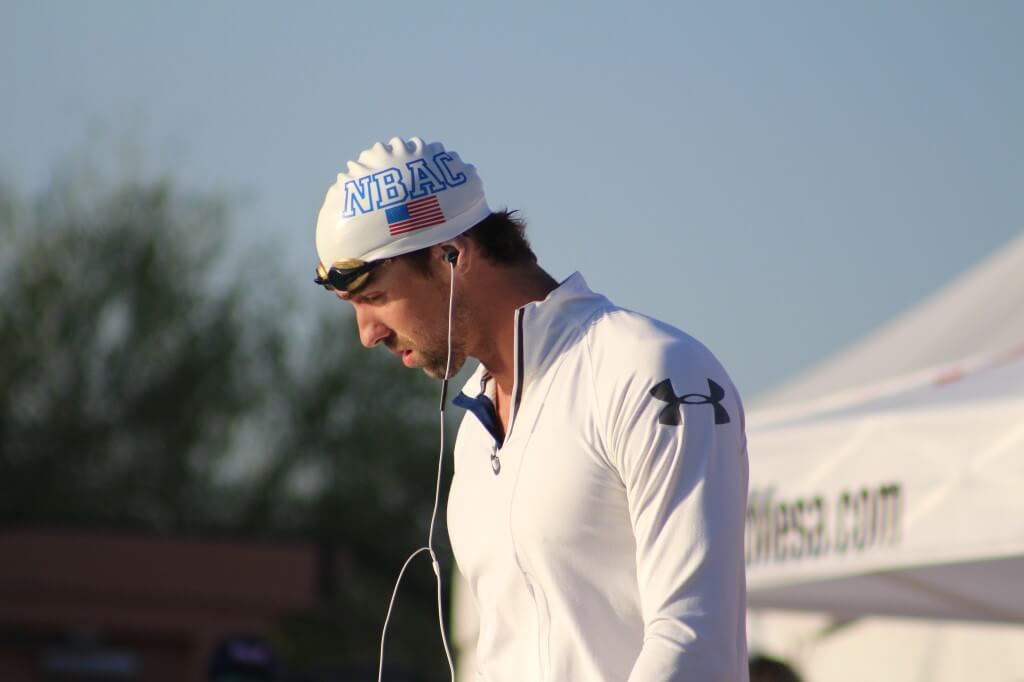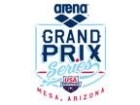Final Impressions on Arena Grand Prix in Mesa

Arena Grand Prix – Mesa editorial coverage is proudly sponsored by Arena USA. Visit ArenaUSA.com for more information on our sponsor. For all the latest coverage, check out our event coverage page. Also, make sure to check out our Facebook photo galleries for the latest images from the meet in Mesa.
Commentary by Duncan Scott
MESA, Arizona, April 28. DUNCAN Scott, one of the top age group swimmers in the history of the sport, is back with his final thoughts on the Arena Grand Prix in Mesa this weekend.
CAREER DURATION
It is a factor that has been growing each year, but with the Micheal Phelps return at 28 it is more noticeable, as is almost anything Michael touches. He’s not alone. World-class entrants in just the Mesa Grand Prix of the same age or older – Arkady Vyatchanin – 30; Matt Grevers – 29; David Plummer – 28; Ryan Lochte – 29; Natalie Coughlin – 31; Michael Alexandrov – 29; Darian Townsend – 29; Noriko Inada – 35; Amanda Weir – 28; Roland Schoeman – 33; Anthony Ervin – 32; And other folks who have experienced high degrees of success in their careers and aged 27,so close to Phelps’ number, included at least Jessica Hardy, Albert Subirats, Marcus Titus, Jason Dunford, Justine (Mueller) Bowker, Scott Weltz, B.J. Johnson.
A remarkable number of these veterans, and a few who may be younger but have still already had careers of long duration, could be heard talking on deck about how much they love the sport, how much fun they were having in swimming, even training; this included some returning after breaks imposed by apparent burnout experiences, from which they had not only recovered but were clearly thriving. The comments directly from these older athletes repeatedly reflected both fun and love in the experience.
WILL THEY OR WON’T THEY?
Significant athletes with long periods of US training/residency apply for citizenship
Double backstroke winner Arkady Vyatchanin and 200 IM winner Darian Townsend, who recently moved to Phoenix after 8-9 years primarily living in Tucson. Both openly spoke in post-race interviews of waiting for results of citizenship requests with hopes of attaining membership on the USA Swimming National team, as has two-time Bulgarian Olympian Mike Alexandrov.
USEFUL WEATHER LAB TEST
Sessions 1-4, like filming a Chamber of Commerce media spot; Session 5 – 25 degree temperature drop and steady wind pushing the center of the backstroke flags 1-2 feet further from the turn end wall and the same amount closer to the start end wall.
Dealing not only with the wind but also the temperature change, was a growth experience for the athletes which hopefully will not be required but might be useful at Olympics, World Championships and Pan Pacs, all of which have been held in outdoor facilities in different years. Pan Pacs in Australia this summer are slated for an outdoor pool literally just a few meters from the ocean, which suggests potential for windy conditions. And, while we certainly hope the weather will be comfortable, it must also be remembered that August in the southern hemisphere are their winter months. Session 5 was a good training ground for potential weather conditions. Another beneficial aspect of Grand Prix meets, some of which are outdoors and some indoors each year.
PHELPSAPALOOZA
Some were unhappy when learning that Michael was only entered in 3 events and scratched one of those before the meet even began. Some felt he disrespected his final event, the 50 free, by announcing in advance that he was going to swim butterfly in his outside lane of one of the championship seeded heat, eventually finishing 42nd out of 89 finishers, thus failing to qualify for A, B, C or D final heats which allow 32 to compete in the finals session.
In listening to Phelps and coach Bowman speak of their meet plan, it was clear the approach was thought through and executed superbly. And with respect toward the meet/sport. His 100 Fly, both morning and night, produced swims within the year’s world top ten while unshaved, albeit with a looonnng stretch into the first turn in the evening. The executed plan for that event was clear and easily appreciated.
The role of the 50 was not as easy to follow, but I believe in the end just as admirable. And well executed as well. As good as his IM, Free and backstroke have been across his career, Fly is his specialty and the most likely area for success in making his return and thus the area he needs to concentrate on, at least initially. His :24.06, according to Bowman’s memory, matched his out split in Beijing, on his way to not only Gold but his still standing :49.82 world record.
It may have only eased him into the top 25 for 2014, but when he’s ready, the second half of his 100 race is stronger than anyone else has ever been. But he’s got to get back as much easy speed as he can. And what I most appreciated, attitude wise, at his final press conference was his clear statement that had he swum fast enough to be in the top 32 he would have come back. The C and D finals, swum after the A, B and relay finals are not the most glamorous; the TV trucks have packed up and left by then (though who knows what adjustments may have been made had Michael been swimming then.) In any event, he expressed that willingness and in fact came back and spent a significant amount of time with Rowdy in the broadcast booth that evening. He didn’t walk out on the event.
It will be fun to follow if, and how, they expand his program as they go through the season. I’d like to see maybe a 100 free, 100 back; and maybe a 200 free. Whether other 200s come into play or not strikes me as possibly unlikely, though he certainly could do a few if he chose to do so at some point
ELIZABETH BEISEL, MICHAEL ANDREW – DIFFERENT APPROACHES
Both have been age group phenoms, with Beisel already passing from that status to a long membership on the national team beginning at age 12 and which continues now at age 21 after completing her Gator career. It includes Olympic teams and a 400 IM World Championship. Beisel has long been thought to be one of the hardest workers in the sport, both in training and in meet workloads. Her final day’s schedule this week included 1600 meters of solid work, even while skipping her primary stroke (2 x 200 Fly; 2 x 200 IM, 800 final heat, skipping 100 back). This practice has consistently allowed her to experience one of the best tapers among her competitors.
Michael II has obviously had great success too and has, to date, continued to improve pretty much across the board with his high intensity/race pace training system, under which he has been regularly doing best times in multiple events at 3-4 meets a month for what seems to be the last 6-9 month. His training regimen has clearly served him well in his record-setting binges. But how will the system work when the measuring stick is specific meets at the end of a calendar competition cycle, rather than reaching the end of the age group. It will be fun to observe how his career continues to develop. Elizabeth’s approach is proven; will Michael II’s be equally effective? More so?
JUST KEEP SWIMMING
For those interested in swimming as a life style, maybe the most impressive swim of the meet came near the very end with the wind again rising and temperature falling, in heat “D” of the Men’s 100 Breast. Representing Rice Aquatics in the Texas-based Gulf LSC, 53 year old David Guthrie swam 1:07.24, less than 0.10 off his 50-54 Masters World record. Good job, Dave.




